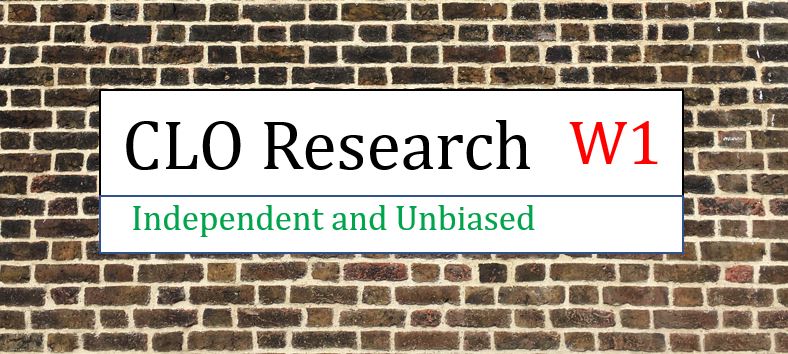“I think that a life properly lived is just learn, learn, learn all the time.” Charlie Munger
Debunking Popular Myths in the CLO Market (Updated)
CLO equity distributions can sometimes be mistaken for returns. It’s crucial to understand that these distributions are distinct from actual returns. That being said, say if an equity tranche has received significant distributions over an extended period, particularly due to an extension of the reinvestment period via a reset, the final equity Internal Rate of Return (IRR) will be less reliant on the final equity Net Asset Value (NAV). The NAV of CLO equity is calculated by dividing the residual collateral value (the Market Value of collateral net of the total CLO debt notional) by the equity tranche notional.
There’s a misconception that wide discounted loan spreads in a weak loan market immediately benefit CLOs with attractive locked-in long-term non-recourse funding. In reality, existing CLOs with a substantial reinvestment period need time to gradually improve their underlying collateral spreads. This improvement will not occur ‘overnight’.
It is commonly believed that during the post-reinvestment period, CLOs will quickly pay down the capital structure. Contrary to this belief, most US Broadly Syndicated Loan (BSL) CLOs and European CLOs continue to reinvest to varying degrees, particularly in the first and second years of the post-reinvestment (post-RI) period.
The assumption that lower Weighted Average Rating Factor (WARF) and Weighted Average Spread (WAS) of the underlying collateral pool always indicate better debt protection can be misleading. These metrics are snapshots in time and do not fully reflect a manager’s return performance over a period. Some managers with low WARF and WAS demonstrate poor protection against market volatility, while others with high WARF and WAS metrics have shown resilience in volatile market conditions.
A CLO BB tranche is often considered capable of withstanding an annual default rate of up to 8%. However, this statement lacks specificity, and assumptions about prepayments can create an overly optimistic outlook, particularly since bad loans are unlikely to be prepaid. If we consider a 7-year period with a consistent annual default rate of 8%, the cumulative default rate would reach 56%. Even allowing for a generous 70% recovery rate, such a high cumulative default rate would be unsustainable for any BB-rated notes.
The solid performance of 1.0 CLO equity from 2006-2007 has led to the expectation that 2.0 CLO equity performance might also be good. However, it is crucial to recognize that the performance between 1.0 and 2.0 CLO equity tranches will differ.
Static deals are generally riskier because they are more leveraged and their portfolios are not actively managed. However, the final equity Internal Rates of Return (IRR) of fully redeemed static deals have been impressive so far. It’s worth noting that sometimes, ‘active management’ can give a false impression of outperformance.
Deals from the 2018 vintage are considered favorable, as they experienced some of the best outcomes in terms of the pricing of CLO liabilities. However, it’s important to note that a good vintage in terms of liability pricing does not necessarily equate to strong performance from the standpoint of underlying asset performance.
US BSL CLOs are generally considered to have lower risk than EU CLOs, owing to their greater depth and diversification. However, recent data on OC test cushions for deals issued between 2012 and 2022 appears to paint a different picture. This insight might prompt investors to reassess their cash flow modeling assumptions for both US BSL and EU CLOs.
Related articles:
Understanding The Commonly Used CLO Deal Metrics and Their Limitations
US BSL CLOs: Latest OC (BB) Test Cushions by Vintage
EU CLOs: Latest OC (Min) Test Cushions by Vintage
A Tale of Two Sets of EU CLO Deals: Fast vs Slow Post-RI Prepay
Seasoned US BSL CLOs: Post-Reinvestment-Period Annual Prepayment Rates Vary
US MM CLOs: Post-Reinvestment-Period Annual Prepayment Rates
Some Reflections on the Drivers of 1.0 US CLO Equity Outperformance
Disclaimers
The information, research, data, research-related opinions, observations, and estimates contained in this document have been compiled or arrived at by CLO Research Group, based upon sources believed to be reliable and accurate, and in good faith, but in each case without further investigation. None of CLO Research Group or its service providers; authorised personnel, or their directors make any expressed or implied presentation or warranty, nor do any of such persons accept any responsibility or liability as to the accuracy, timeliness, completeness, or correctness of such sources and the information, research, data, research related opinions, observations and estimates contained in this document. All information, research, data, research-related opinions, observations, and estimates in this document are in draft form as of the date of this document and remain subject to change and amendment without notice. Neither CLO Research Group nor any of their third-party providers shall be subject to any damages or liability for any errors, omissions, incompleteness, or incorrectness of this document. This article is not and should not be construed as an offer, or a solicitation of an offer, to buy or sell securities and shall not be relied upon as a promise or representation regarding the historical or current position or performance of any of the deals or issues mentioned in it.





